Fast and accurate CO2 monitoring for rats and larger animals
CapStar-100
- End-tidal or continuous CO2 monitoring
- Measures respiration rate (RR)
- Small sample flow requirements.
- Suitable for rats and larger animals
- Adjustable ETCO2 and RR alarms
- Analog output signal and RS232 serial data output
- Use with ventilated or unassisted breathing animals
- Control-of-breathing studies and basic monitoring
- Carbon dioxide sensor: single beam infrared
- Sample inlet connector: Luer female
- Measurement range: 0-10% CO2
- Linearity: 0.1% CO2
- Repeatability: 0.1% CO2
- Response time (T10 - T90): 110mS at 60 ml/min sampling
- Response time (T10 - T90): 100mS at 100 ml/min sampling
- Zero stability: 0.1% (8 hours), 0.2% (24 hours)
- Interference effects: 50% N2O: 0.1% at 0% CO2, 0.6% at 5% CO2 (uncomp.)
- Interference effects: vaporized anesthetic agents: negligible
- Operating temperature range: 5-40° C
- Optical bench temperature: 48° C, controlled
- Warm-up time: 6 min to 0.2%, 10 min to 0.1%
- Sample flow adjustment range: 10 - 200 ml/min
- Respiratory rate measurement range: 5 – 120 breaths/min
- Alarm adjustment range: ETCO2: 1.0 – 9.9%
- Alarm adjustment range: Respiratory Rate: 5 – 120 breaths/min
- Analog signal output: BNC jacks
- CO2 output scaling: 0.4V / %CO2
- Serial data output format: 9600 baud, 8 data, no parity, 1 stop bit
- Power adapter (supplied): 5VDC@4A
- Mains requirements for power adapter: 120VAC/220VAC universal
- Dimensions: 9W x 4H x 9D in. (23 x 10 x 23cm)
- Weight: 4 lbs. (1.8kg)
The heart of the instrument is a miniature infrared analyzer with exceptional stability, low maintenance, and a linear output. The heated measurement cell prevents water condensation. in minutes. The graphic LCD display shows CO2 concentration in percent or mmHg, and allows breath-by-breath peak end-tidal reading (ETCO2) or continuous rapid response. Calibration is performed with a single calibrated gas and room air.
The reliability and ease of operation of the CapStar-100 make it the perfect instrument for routine respiratory CO2 monitoring. It is the natural companion to our SAR-830 series Small Animal Ventilators for monitoring respiratory status. With the AVS-1 Advanced Ventilator System, it can control end-tidal CO2. It can also be used to monitor unassisted animals. Gas sampling rates of less than 30ml/min can be used, making it possible to monitor animals as small as rats. The fast response time of the CapStar-100 allows end-tidal response plateaus with respiratory rates of 100 breaths/min.
A range of accessories is available to ensure easy setup and convenient operation. An accessory pack containing sample tubing, moisture traps, and Nafion® moisture-absorbing sample tubes is included with the instrument.
CWE, Inc CapStar-100 Calibration Video
In this video you will learn the preferred method for calibrating the CapStar-100 from CWE, Inc. No matter how you introduce the calibration gas the most important concept is to avoid pressurizing the sensor.

